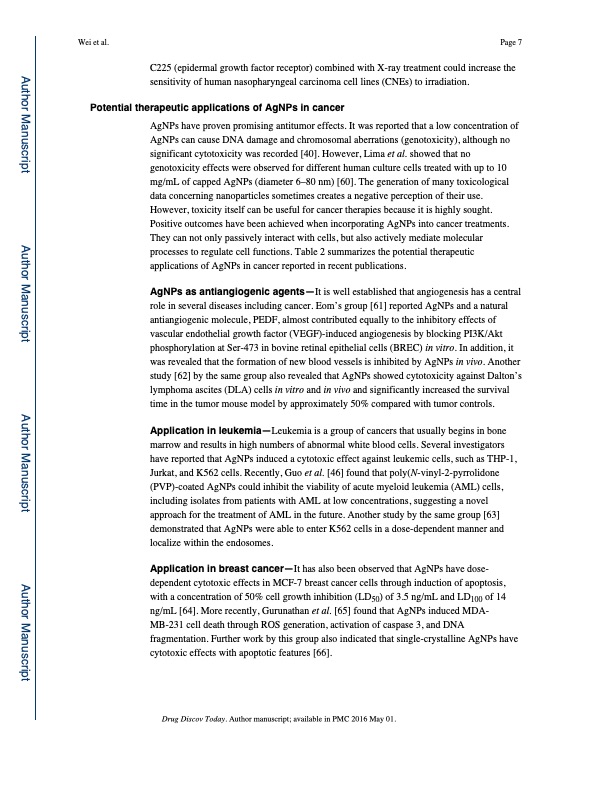
PDF Publication Title:
Text from PDF Page: 007
Wei et al. Page 7 C225 (epidermal growth factor receptor) combined with X-ray treatment could increase the sensitivity of human nasopharyngeal carcinoma cell lines (CNEs) to irradiation. Potential therapeutic applications of AgNPs in cancer AgNPs have proven promising antitumor effects. It was reported that a low concentration of AgNPs can cause DNA damage and chromosomal aberrations (genotoxicity), although no significant cytotoxicity was recorded [40]. However, Lima et al. showed that no genotoxicity effects were observed for different human culture cells treated with up to 10 mg/mL of capped AgNPs (diameter 6–80 nm) [60]. The generation of many toxicological data concerning nanoparticles sometimes creates a negative perception of their use. However, toxicity itself can be useful for cancer therapies because it is highly sought. Positive outcomes have been achieved when incorporating AgNPs into cancer treatments. They can not only passively interact with cells, but also actively mediate molecular processes to regulate cell functions. Table 2 summarizes the potential therapeutic applications of AgNPs in cancer reported in recent publications. AgNPs as antiangiogenic agents—It is well established that angiogenesis has a central role in several diseases including cancer. Eom’s group [61] reported AgNPs and a natural antiangiogenic molecule, PEDF, almost contributed equally to the inhibitory effects of vascular endothelial growth factor (VEGF)-induced angiogenesis by blocking PI3K/Akt phosphorylation at Ser-473 in bovine retinal epithelial cells (BREC) in vitro. In addition, it was revealed that the formation of new blood vessels is inhibited by AgNPs in vivo. Another study [62] by the same group also revealed that AgNPs showed cytotoxicity against Dalton’s lymphoma ascites (DLA) cells in vitro and in vivo and significantly increased the survival time in the tumor mouse model by approximately 50% compared with tumor controls. Application in leukemia—Leukemia is a group of cancers that usually begins in bone marrow and results in high numbers of abnormal white blood cells. Several investigators have reported that AgNPs induced a cytotoxic effect against leukemic cells, such as THP-1, Jurkat, and K562 cells. Recently, Guo et al. [46] found that poly(N-vinyl-2-pyrrolidone (PVP)-coated AgNPs could inhibit the viability of acute myeloid leukemia (AML) cells, including isolates from patients with AML at low concentrations, suggesting a novel approach for the treatment of AML in the future. Another study by the same group [63] demonstrated that AgNPs were able to enter K562 cells in a dose-dependent manner and localize within the endosomes. Application in breast cancer—It has also been observed that AgNPs have dose- dependent cytotoxic effects in MCF-7 breast cancer cells through induction of apoptosis, with a concentration of 50% cell growth inhibition (LD50) of 3.5 ng/mL and LD100 of 14 ng/mL [64]. More recently, Gurunathan et al. [65] found that AgNPs induced MDA- MB-231 cell death through ROS generation, activation of caspase 3, and DNA fragmentation. Further work by this group also indicated that single-crystalline AgNPs have cytotoxic effects with apoptotic features [66]. Drug Discov Today. Author manuscript; available in PMC 2016 May 01. Author Manuscript Author Manuscript Author Manuscript Author ManuscriptPDF Image | Silver nanoparticles: synthesis, properties, therapeutic apps

PDF Search Title:
Silver nanoparticles: synthesis, properties, therapeutic appsOriginal File Name Searched:
nihms651778.pdfDIY PDF Search: Google It | Yahoo | Bing
Turbine and System Plans CAD CAM: Special for this month, any plans are $10,000 for complete Cad/Cam blueprints. License is for one build. Try before you buy a production license. More Info
Waste Heat Power Technology: Organic Rankine Cycle uses waste heat to make electricity, shaft horsepower and cooling. More Info
All Turbine and System Products: Infinity Turbine ORD systems, turbine generator sets, build plans and more to use your waste heat from 30C to 100C. More Info
CO2 Phase Change Demonstrator: CO2 goes supercritical at 30 C. This is a experimental platform which you can use to demonstrate phase change with low heat. Includes integration area for small CO2 turbine, static generator, and more. This can also be used for a GTL Gas to Liquids experimental platform. More Info
Introducing the Infinity Turbine Products Infinity Turbine develops and builds systems for making power from waste heat. It also is working on innovative strategies for storing, making, and deploying energy. More Info
Need Strategy? Use our Consulting and analyst services Infinity Turbine LLC is pleased to announce its consulting and analyst services. We have worked in the renewable energy industry as a researcher, developing sales and markets, along with may inventions and innovations. More Info
Made in USA with Global Energy Millennial Web Engine These pages were made with the Global Energy Web PDF Engine using Filemaker (Claris) software.
Infinity Turbine Developing Spinning Disc Reactor SDR or Spinning Disc Reactors reduce processing time for liquid production of Silver Nanoparticles.
| CONTACT TEL: 608-238-6001 Email: greg@infinityturbine.com | RSS | AMP |